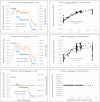Water without windows: Evaluating the performance of open cell transmission electron microscopy under saturated water vapor conditions, and assessing its potential for microscopy of hydrated biological specimens
- PMID: 29099843
- PMCID: PMC5669482
- DOI: 10.1371/journal.pone.0186899
Water without windows: Evaluating the performance of open cell transmission electron microscopy under saturated water vapor conditions, and assessing its potential for microscopy of hydrated biological specimens
Abstract
We have performed open cell transmission electron microscopy experiments through pure water vapor in the saturation pressure regime (>0.6 kPa), in a modern microscope capable of sub-Å resolution. We have systematically studied achievable pressure levels, stability and gas purity, effective thickness of the water vapor column and associated electron scattering processes, and the effect of gas pressure on electron optical resolution and image contrast. For example, for 1.3 kPa pure water vapor and 300kV electrons, we report pressure stability of ± 20 Pa over tens of minutes, effective thickness of 0.57 inelastic mean free paths, lattice resolution of 0.14 nm on a reference Au specimen, and no significant degradation in contrast or stability of a biological specimen (M13 virus, with 6 nm body diameter). We have also done some brief experiments to confirm feasibility of loading specimens into an in situ water vapor ambient without exposure to intermediate desiccating conditions. Finally, we have also checked if water experiments had any discernible impact on the microscope performance, and report pertinent vacuum and electron optical data, for reference purposes.
Conflict of interest statement
Figures











References
-
- Jinschek JR. Advances in the environmental transmission electron microscope (ETEM) for nanoscale in situ studies of gas-solid interactions. Chemical Communications. 2014;50:2696–2706. doi: 10.1039/C3CC49092K - DOI - PubMed
-
- Ek M, Jespersen SPF, Damsgaard CD, Helveg S. On the role of the gas environment, electron-dose-rate, and sample on the image resolution in the transmission electron microscope. Advanced Structural and Chemical Imaging. 2016;2(4):1–8.
-
- Cameron RE, McDonald AM. Minimizing sample evaporation in the environmental scanning electron microscope. Journal of Microscopy. 1994;173(3):227–237. doi: 10.1111/j.1365-2818.1994.tb03445.x - DOI
-
- Ross FM, Wang C, de Jonge N. Transmission electron microscopy of specimens and processes in liquids. MRS Bulletin. 2016;41:791–799. doi: 10.1557/mrs.2016.212 - DOI
-
- Ross FM. Opportunities and challenges in liquid cell electron microscopy. Science. 2015;350(6267):aaa9886–1–aaa9886–9. doi: 10.1126/science.aaa9886 - DOI - PubMed
MeSH terms
Substances
LinkOut - more resources
Full Text Sources
Other Literature Sources

